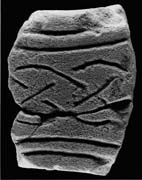Select a site alphabetically from the choices shown in the box below. Alternatively, browse sculptural examples using the Forward/Back buttons.
Chapters for this volume, along with copies of original in-text images, are available here.
Object type: Fragment of cross-arm, in two joining pieces
Measurements: H. 9.6 cm (3.75 in); W. 12.6 cm (5 in); D. 6.6 cm (2.6 in)
Stone type: Fine-grained, very pale brown (10YR 7/3, burnt pink (5YR 7/3) on face A) sandstone; Middle Calcareous Grit, Coralline Oolite Formation, Middle Oxfordian, Upper Jurassic; perhaps from Stonegrave
Plate numbers in printed volume: 872-877
Corpus volume reference: Vol 3 p. 222
(There may be more views or larger images available for this item. Click on the thumbnail image to view.)
Only one face is decorated, the others being plain; the central section of one arm of a free-armed cross-head.
A (broad): A plain double edge moulding curves in a wide arc, suggesting a cusped arm. Within the panel is part of a run of four-strand plain plait, executed in incised technique, the strands being stopped well in advance of the crossings.
The wide arc and the light interlace are marks of Anglian workmanship. Cramp has likened the incised plait to Lindisfarne 10A, Northumberland (Peers 1923–4, 269, xi, fig. 6; Cramp 1984, I, 198–9, fig. 19, II, pl. 194, 1088). More local manifestations are found on the Lastingham chair (no. 10; Ills. 623–4) and on Stonegrave 2 (Ills. 825, 827). It is not mere roughing out of interlace left unfinished; rather, it gives a lighter touch, and may have been used as a median incision to painted strands. The geology of the piece, perhaps pointing to Stonegrave, a known pre-Conquest monastery, along with parallels for incised interlace, both suggest East Riding links with ecclesiastical centres in Ryedale in the eighth and ninth centuries.



